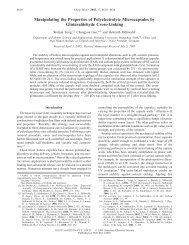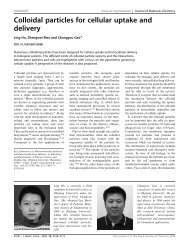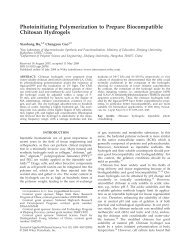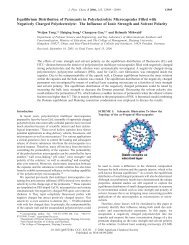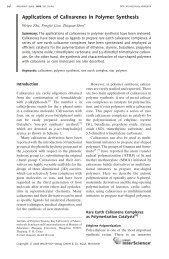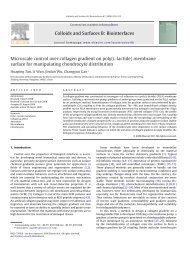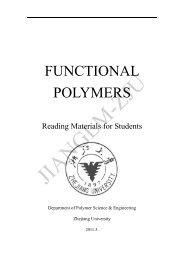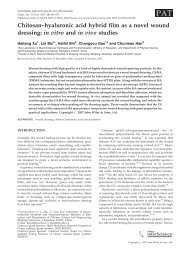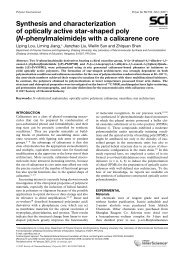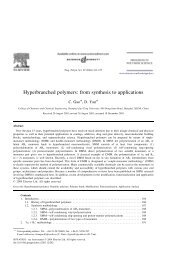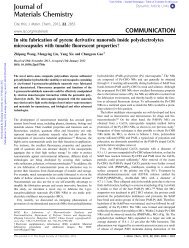Protein immobilization on the surface of poly-L-lactic acid films for ...
Protein immobilization on the surface of poly-L-lactic acid films for ...
Protein immobilization on the surface of poly-L-lactic acid films for ...
You also want an ePaper? Increase the reach of your titles
YUMPU automatically turns print PDFs into web optimized ePapers that Google loves.
European Polymer Journal 38 (2002) 2279–2284www.elsevier.com/locate/europolj<str<strong>on</strong>g>Protein</str<strong>on</strong>g> <str<strong>on</strong>g>immobilizati<strong>on</strong></str<strong>on</strong>g> <strong>on</strong> <strong>the</strong> <strong>surface</strong> <strong>of</strong> <strong>poly</strong>-L-<strong>lactic</strong><strong>acid</strong> <strong>films</strong> <strong>for</strong> improvement <strong>of</strong> cellular interacti<strong>on</strong>sZuwei Ma, Changyou Gao * , Jian Ji, Jiac<strong>on</strong>g ShenDepartment <strong>of</strong> Polymer Science and Engineering, Zhejiang University, Hangzhou 310027, ChinaReceived 13 August 2001; received in revised <strong>for</strong>m 8 April 2002; accepted 16 April 2002AbstractTo covalently immobilize gelatin or collagen type I <strong>on</strong> <strong>poly</strong>-L-<strong>lactic</strong> <strong>acid</strong> (PLLA) film <strong>surface</strong>s <strong>poly</strong>(hydroxyethylmethacrylate) (PHEMA) or <strong>poly</strong>(methacrylic <strong>acid</strong>) (PMAA) was grafted via photooxidizati<strong>on</strong> and subsequent UVinduced<strong>poly</strong>merizati<strong>on</strong> [Makromol. Chem. 186 (1985) 1533.1]. For <strong>films</strong> grafted with PHEMA, methyl sulf<strong>on</strong>ylchloride was used to activate <strong>the</strong> hydroxyl groups and <strong>for</strong> <strong>films</strong> grafted with PMAA 1-ethyl-3-(3-dimethylaminopropyl)carbodiimide was used to activate <strong>the</strong> carboxyl groups. Gelatin and collagen were finally reacted with <strong>the</strong> activatedhydroxyl or carboxyl groups to obtain covalently immobilized protein layers. Grafting <strong>of</strong> PHEMA, PMAA and protein<strong>on</strong> <strong>the</strong> <strong>surface</strong>s was c<strong>on</strong>firmed using ATR-IR and XPS. Surface wettability <strong>of</strong> <strong>the</strong> modified <strong>films</strong> was improved. Theprotein immobilized PLLA may be widely used as a biocompatible material.Ó 2002 Elsevier Science Ltd. All rights reserved.Keywords: Poly-L-<strong>lactic</strong> <strong>acid</strong>; Surface modificati<strong>on</strong>; <str<strong>on</strong>g>Protein</str<strong>on</strong>g> <str<strong>on</strong>g>immobilizati<strong>on</strong></str<strong>on</strong>g>; Biocompatibility1. Introducti<strong>on</strong>In recent years, many biodegradable <strong>poly</strong>mers havebeen used in tissue engineering to build three-dimensi<strong>on</strong>alporous materials to provide scaffolds <strong>for</strong> cellstowards regenerati<strong>on</strong> <strong>of</strong> tissue engineered organs such asliver [2], articulate cartilage [3] and artificial skin [4].Am<strong>on</strong>g <strong>the</strong>se biodegradable <strong>poly</strong>mers, <strong>poly</strong>-L-<strong>lactic</strong> <strong>acid</strong>(PLLA) is widely used due to its biodegradability, goodmechanical properties and proper degradati<strong>on</strong> ratewhich is <strong>of</strong>ten comparable with <strong>the</strong> healing time <strong>of</strong> <strong>the</strong>damaged human tissues. Transplantati<strong>on</strong> <strong>of</strong> isolatedcells seeded in biodegradable PLLA scaffold has beeninvestigated as a means <strong>of</strong> producing biologic substitutesto regenerate or replace <strong>the</strong> damaged tissue such as articulatecartilage [5].* Corresp<strong>on</strong>ding author. Tel.: +86-571-87951108; fax: +86-571-87951948.E-mail address: cygao@mail.hz.zj.cn (C. Gao).However, <strong>on</strong>e great limitati<strong>on</strong> <strong>of</strong> PLLA is <strong>the</strong> lack <strong>of</strong>compatibility <strong>for</strong> cells. It is difficult to transplant isolatedcells in PLLA scaffold because cell attachment <strong>on</strong>PLLA is ra<strong>the</strong>r low due to its hydrophobicity [6]. Oneapproach to solve this problem is to immobilize a biocompatiblelayer <strong>on</strong> <strong>the</strong> <strong>surface</strong> <strong>of</strong> <strong>the</strong> <strong>poly</strong>mer to improvecell-material interacti<strong>on</strong>s. In recent years proteinor oligopeptide <str<strong>on</strong>g>immobilizati<strong>on</strong></str<strong>on</strong>g> <strong>on</strong> <strong>poly</strong>mer <strong>surface</strong>s toimprove biocompatibility is <strong>of</strong> much interest. Immobilizati<strong>on</strong><strong>of</strong> some special biologically active molecules <strong>on</strong>syn<strong>the</strong>tic materials is <strong>of</strong> critical importance since <strong>the</strong>ycan in principle elicit some specific, predictable andc<strong>on</strong>trolled resp<strong>on</strong>ses from <strong>the</strong> cells seeded <strong>on</strong> <strong>the</strong> materials.To covalently immobilize protein molecules <strong>on</strong> achemically inert <strong>poly</strong>mer <strong>surface</strong> such as PLLA, it isnecessary to introduce some reactive groups such ashydroxyl (–OH), carboxyl (–COOH) or amino groups<strong>on</strong> <strong>the</strong> <strong>poly</strong>mer <strong>surface</strong>. Many methods like plasmatreatment in amm<strong>on</strong>ia [7], plasma induced grafting<strong>poly</strong>merizati<strong>on</strong> [8], photo-induced grafting <strong>poly</strong>merizati<strong>on</strong>[9] and oz<strong>on</strong>e oxidizati<strong>on</strong> [10] have been used to0014-3057/02/$ - see fr<strong>on</strong>t matter Ó 2002 Elsevier Science Ltd. All rights reserved.PII: S0014-3057(02)00119-2
2280 Z. Ma et al. / European Polymer Journal 38 (2002) 2279–2284Fig. 1. Schematic representati<strong>on</strong> <strong>of</strong> <strong>the</strong> reacti<strong>on</strong> protocol <strong>for</strong> <str<strong>on</strong>g>immobilizati<strong>on</strong></str<strong>on</strong>g> <strong>of</strong> protein <strong>on</strong> PLLA film <strong>surface</strong>s, where H 2 N–Prepresents a protein molecule.introduce <strong>the</strong> above reactive groups <strong>on</strong> <strong>poly</strong>mer <strong>surface</strong>s.<str<strong>on</strong>g>Protein</str<strong>on</strong>g> molecules can be subsequently immobilizedusing chemical methods such as carbodiimidechemistry [11] or sulf<strong>on</strong>yl chloride chemistry [12].Collagen is <strong>on</strong>e <strong>of</strong> <strong>the</strong> most important biologicalmacromolecules <strong>of</strong> <strong>the</strong> extracellular matrix in tissues, andhas been used successfully to produce commercializedbiomaterials <strong>for</strong> a wide range <strong>of</strong> applicati<strong>on</strong>s includingburn dressings, hemostats and s<strong>of</strong>t tissue augmentati<strong>on</strong>[13]. Haw Suh has grafted type I atelocollagen <strong>on</strong> oz<strong>on</strong>eoxidized PLLA <strong>films</strong> and <strong>the</strong> compatibility <strong>of</strong> <strong>the</strong> modified<strong>films</strong> <strong>for</strong> osteoblasts was improved significantly [10].Gelatin, which is <strong>the</strong> product <strong>of</strong> hydrolysis <strong>of</strong> collagen,has also been used in modifying syn<strong>the</strong>tic biomaterials.Yamaoka has immobilized gelatin <strong>on</strong> <strong>the</strong> <strong>surface</strong> <strong>of</strong>PLLA by reacting <strong>the</strong> material directly with an alkalinesoluti<strong>on</strong> <strong>of</strong> gelatin. The modified PLLA has better cellattachment property <strong>for</strong> 3T3 fibroblasts [14]. The success<strong>of</strong> gelatin and collagen may be attributed to <strong>the</strong>ir naturalorigin and low immunogenicity [15].In this study, PLLA <strong>films</strong> grafted with <strong>poly</strong>(hydroxyethylmethacrylate) (PHEMA) or <strong>poly</strong>(methacrylic<strong>acid</strong>) (PMAA) were prepared via <strong>the</strong> photooxidizati<strong>on</strong>and subsequent UV-induced <strong>poly</strong>merizati<strong>on</strong> [1]. Gelatinor collagen was <strong>the</strong>n covalently immobilized <strong>on</strong> <strong>the</strong> film<strong>surface</strong>s via <strong>the</strong> reacting groups (OH or COOH), asshown in Fig. 1.2. Experiment2.1. MaterialsPLLA was syn<strong>the</strong>sized using <strong>the</strong> method described in[16]. PLLA <strong>films</strong> were prepared by casting a 1,4-dioxanesoluti<strong>on</strong> c<strong>on</strong>taining 6 wt.% <strong>of</strong> PLLA (M n ¼ 200,000,M w ¼ 400,000) <strong>on</strong>to a stainless steel plate. Films weredried to c<strong>on</strong>stant weight and had a thickness <strong>of</strong> 0.5 mm.Hydroxyethyl methacrylate (HEMA, Sigma) and methacrylic<strong>acid</strong> (MAA, Sigma) were purified by distillati<strong>on</strong>under vacuum. Water-soluble carbodiimide, 1-ethyl-3-(3-dimethylaminopropyl) carbodiimide (EDAC) andmethyl sulf<strong>on</strong>yl chloride were purchased from Aldrich.Gelatin and collagen type I were purchased from Sigma.2.2. Photooxidizati<strong>on</strong> and graft <strong>poly</strong>merizati<strong>on</strong>The PLLA film was placed in 40 ml hydrogen peroxidesoluti<strong>on</strong> (30%) and irradiated with UV light generatedfrom a high-pressure mercury lamp (250 W) <strong>for</strong>40 min at 50 °C. The photooxidized film was rinsed withdei<strong>on</strong>ized water and dried at room temperature in vacuum<strong>for</strong> 4 h to remove excess hydrogen peroxide. Thefilm was <strong>the</strong>n immersed into an aqueous m<strong>on</strong>omer soluti<strong>on</strong>with a given c<strong>on</strong>centrati<strong>on</strong> in a Pyrex glass tubepurged with nitrogen. Graft <strong>poly</strong>merizati<strong>on</strong> was carriedout under UV irradiati<strong>on</strong> at a distance <strong>of</strong> 12.5 cm <strong>for</strong> 60min at 50 °C. The grafted film was rinsed with dei<strong>on</strong>izedwater at 70 °C <strong>for</strong> 24 h to remove <strong>the</strong> homo<strong>poly</strong>mers[17].2.3. Immobilizati<strong>on</strong> <strong>of</strong> protein2.3.1. Method IThe PLLA-g-PHEMA film was introduced into aglass tube c<strong>on</strong>taining 2 ml methyl sulf<strong>on</strong>yl chloride and20 ml diethyle<strong>the</strong>r. After incubati<strong>on</strong> at 20 °C <strong>for</strong> 2 hgelatin or collagen soluti<strong>on</strong> with given c<strong>on</strong>centrati<strong>on</strong>was reacted with <strong>the</strong> activated film <strong>for</strong> 24 h at 30 °C.
Z. Ma et al. / European Polymer Journal 38 (2002) 2279–2284 22812.3.2. Method IIThe COOH residues <strong>on</strong> <strong>the</strong> film <strong>surface</strong> were activatedat 0 °C <strong>for</strong> 4 h in EDAC phosphate buffer soluti<strong>on</strong> (10mg/ml, pH 7.4). Then <strong>the</strong> gelatin or collagen in phosphatebuffer soluti<strong>on</strong> (pH 4.5) with given c<strong>on</strong>centrati<strong>on</strong>was reacted with <strong>the</strong> activated film <strong>for</strong> 24 h at 0 °C.The protein immobilized PLLA <strong>films</strong> were rinsed withdei<strong>on</strong>ized water at 37 °C <strong>for</strong> 24 h. The film was slightlybrushed with a cott<strong>on</strong> tamp<strong>on</strong> to aid <strong>the</strong> removal <strong>of</strong>n<strong>on</strong>e-grafted (adsorbed) protein. To c<strong>on</strong>firm that <strong>the</strong>adsorbed protein could be removed completely, PLLA,PLLA-g-PHEMA and PLLA-g-PMAA <strong>films</strong> were directlyimmersed in gelatin or collagen soluti<strong>on</strong> andrinsed as described above. In <strong>the</strong> XPS spectra <strong>of</strong> <strong>the</strong>se<strong>films</strong> <strong>the</strong>re were no nitrogen peaks. However, peaks <strong>of</strong>nitrogen were detected in XPS spectra <strong>of</strong> <strong>the</strong> proteingrafted PLLA <strong>films</strong>.2.4. Characterizati<strong>on</strong>The c<strong>on</strong>tent <strong>of</strong> hydroperoxide groups <strong>on</strong> <strong>the</strong> film<strong>surface</strong> was determined by <strong>the</strong> iodometry method [18].ATR-IR spectra were obtained <strong>on</strong> a Nicolet Magna-IR560 machine. XPS spectra were recorded with aESCA LAB Mark II spectrometer employing AlK a excitati<strong>on</strong>radiati<strong>on</strong>. The charging shift was referred to <strong>the</strong>C 1s line emitted from <strong>the</strong> saturated hydrocarb<strong>on</strong> at 285.0eV. The take <strong>of</strong>f angle <strong>of</strong> <strong>the</strong> XPS was 30°. To calculate<strong>the</strong> atomic ratio <strong>of</strong> N to C <strong>on</strong> <strong>the</strong> outer-most layer <strong>of</strong> <strong>the</strong>protein immobilized PLLA <strong>films</strong>, <strong>the</strong> collecting factor <strong>of</strong>1.77:1 (N:C) were used. The <strong>surface</strong> density <strong>of</strong> <strong>the</strong>grafted protein <strong>on</strong> <strong>the</strong> PLLA <strong>films</strong> was determined by<strong>the</strong> ninhydrin method [19]. Each value was averagedfrom five times measurements.Static water c<strong>on</strong>tact angles were obtained <strong>on</strong> aKRUSS DSA10-MK machine. The sessile c<strong>on</strong>tact anglewas determined by placing a drop <strong>of</strong> water (0.8 ll) <strong>on</strong><strong>the</strong> <strong>surface</strong> and recording <strong>the</strong> angle between <strong>the</strong> horiz<strong>on</strong>talplane and <strong>the</strong> tangent to <strong>the</strong> drop at <strong>the</strong> point <strong>of</strong>c<strong>on</strong>tact with <strong>the</strong> substrate. Captive bubble c<strong>on</strong>tact angles(CBCA) were measured by observing <strong>the</strong> air bubblein water at room temperature within 30 s after it c<strong>on</strong>tacted<strong>the</strong> <strong>poly</strong>mer <strong>surface</strong>. For both methods, eachvalue was averaged from 15 measurements.3. Results and discussi<strong>on</strong>3.1. Grafting <strong>of</strong> PHEMA and PMAA <strong>on</strong>to <strong>the</strong> <strong>surface</strong>s <strong>of</strong>PLLA <strong>films</strong>As <strong>the</strong> first step <strong>of</strong> <strong>the</strong> <str<strong>on</strong>g>immobilizati<strong>on</strong></str<strong>on</strong>g> <strong>of</strong> protein,hydroperoxide groups were introduced <strong>on</strong> <strong>the</strong> PLLAfilm <strong>surface</strong>s via photooxidizati<strong>on</strong> in hydrogen peroxidesoluti<strong>on</strong> under UV light. The <strong>surface</strong> density <strong>of</strong> <strong>the</strong> hydroperoxidegroups was 1:5 0:1 10 6 mol/cm 2 asdetermined with <strong>the</strong> iodometry method [18], whichwould represent about 90 hydroperoxide groups persquare A. Giving such a high degree <strong>of</strong> PLLA oxidizati<strong>on</strong>,it also seemed unreas<strong>on</strong>able that <strong>the</strong>re was nodifference in water c<strong>on</strong>tact angle between c<strong>on</strong>trol PLLAfilm and <strong>the</strong> oxidized <strong>on</strong>e (Table 2). The reas<strong>on</strong>ableexplanati<strong>on</strong> could be that even though PLLA is hydrophobic,<strong>the</strong> hydrogen peroxide molecules could stillpermeate into <strong>the</strong> bulk PLLA at 50 °C so that <strong>the</strong>photooxidizati<strong>on</strong> <strong>of</strong> PLLA <strong>films</strong> occurred not <strong>on</strong>ly <strong>on</strong><strong>the</strong> <strong>surface</strong> but also in <strong>the</strong> bulk material. The hydroperoxidegroups in <strong>the</strong> inner layer could also be decomposedand induce <strong>the</strong> graft <strong>poly</strong>merizati<strong>on</strong>.Under UV light <strong>the</strong> hydroperoxide groups <strong>on</strong> <strong>the</strong> film<strong>surface</strong> decomposed into macromolecular radicals andfree hydroxyl radicals. The macromolecular radicals caninitiate grafting while <strong>the</strong> hydroxyl radicals initiatehomo<strong>poly</strong>merizati<strong>on</strong>. The ATR spectra <strong>of</strong> <strong>the</strong> PLLA<strong>films</strong> grafted with PHEMA or PMAA are shown in Fig.2. The broad absorpti<strong>on</strong> between 3000 and 3700 cm 1was assigned to <strong>the</strong> stretching vibrati<strong>on</strong> <strong>of</strong> O–H in hydroxylgroups <strong>of</strong> PHEMA or carboxyl groups <strong>of</strong>PMAA. On <strong>the</strong> PMAA grafted film some carboxylFig. 2. ATR-IR spectra <strong>of</strong> <strong>the</strong> c<strong>on</strong>trol and modified PLLA <strong>films</strong>: (a) method I and (b) method II.
2282 Z. Ma et al. / European Polymer Journal 38 (2002) 2279–2284Fig. 3. XPS spectra <strong>of</strong> <strong>the</strong> c<strong>on</strong>trol and modified PLLA <strong>films</strong>: (a) C 1s core level scan spectra <strong>of</strong> <strong>the</strong> c<strong>on</strong>trol and modified PLLA <strong>films</strong> and(b) survey scan spectrum <strong>of</strong> <strong>the</strong> protein grafted PLLA film.groups were transferred to carboxylate groups (–COO )and part <strong>of</strong> <strong>the</strong> carb<strong>on</strong>yl absorpti<strong>on</strong> was moved from1750 to 1700 cm 1 (Fig. 2). The alterati<strong>on</strong> <strong>of</strong> <strong>the</strong> <strong>surface</strong>chemical compositi<strong>on</strong> was fur<strong>the</strong>r investigated byXPS (Fig. 3). The C 1s spectra <strong>of</strong> <strong>the</strong> c<strong>on</strong>trol PLLA,PLLA-g-PHEMA and PLLA-g-PMAA <strong>films</strong> all gavethree main peaks with binding energies at 285.0,286.6 and 289.0 eV, corresp<strong>on</strong>ding to carb<strong>on</strong> atoms<strong>of</strong> saturated hydrocarb<strong>on</strong>s, carb<strong>on</strong> atoms with a singleb<strong>on</strong>d to oxygen (O–C–C@O or–C–O–C@O) and carb<strong>on</strong>atoms in carb<strong>on</strong>yl groups (–C@O) [20,21]. In <strong>the</strong>C 1s spectra <strong>of</strong> PLLA-g-PHEMA and PLLA-g-PMAA<strong>films</strong>, <strong>the</strong> peaks at 285.0 eV were larger than that <strong>of</strong> <strong>the</strong>c<strong>on</strong>trol film because both PHEMA and PMAA havehigher c<strong>on</strong>tent <strong>of</strong> saturated hydrocarb<strong>on</strong>s (50% and75%, respectively) than PLLA (33%). In <strong>the</strong> C 1s spectrum<strong>of</strong> <strong>the</strong> film grafted with PMAA, <strong>the</strong> peak at 286.6eV was much smaller because PMAA does not havecarb<strong>on</strong> atoms with a single b<strong>on</strong>d to oxygen. These datac<strong>on</strong>firm <strong>the</strong> occurrence <strong>of</strong> grafting <strong>of</strong> PHEMA orPMAA <strong>on</strong> <strong>the</strong> PLLA film <strong>surface</strong>s.3.2. Immobilizati<strong>on</strong> <strong>of</strong> proteins <strong>on</strong> <strong>the</strong> PLLA <strong>films</strong>Gelatin and collagen were covalently immobilized <strong>on</strong><strong>the</strong> PLLA <strong>surface</strong>s using two methods. In method I <strong>the</strong>hydroxyl groups <strong>on</strong> <strong>the</strong> PLLA-g-PHEMA <strong>surface</strong>s werereacted with methyl sulf<strong>on</strong>yl chloride to <strong>for</strong>m sulf<strong>on</strong>ategroups. Then, amino groups <strong>of</strong> <strong>the</strong> protein moleculeswere reacted with <strong>the</strong> sulf<strong>on</strong>ate groups to produce acovalent combinati<strong>on</strong>. In method II, EDAC was used toactivate <strong>the</strong> carboxyl groups <strong>on</strong> <strong>the</strong> PLLA-g-PMAA film<strong>surface</strong>s. The activated carboxyl groups were <strong>the</strong>n reactedwith amino groups <strong>of</strong> protein molecules.ATR spectra <strong>of</strong> <strong>the</strong> protein immobilized PLLA <strong>films</strong>are shown in Fig. 2. Absorpti<strong>on</strong> at 1600 cm 1 c<strong>on</strong>firmed<strong>the</strong> presence <strong>of</strong> amide b<strong>on</strong>ds <strong>on</strong> <strong>the</strong> protein immobilizedfilm <strong>surface</strong>s. In <strong>the</strong> XPS spectra <strong>of</strong> <strong>the</strong> protein immobilized<strong>films</strong> <strong>the</strong>re appeared N 1s peaks (Fig. 3), which directlyc<strong>on</strong>firmed <strong>the</strong> grafting <strong>of</strong> protein. The atomicratios <strong>of</strong> N to C <strong>on</strong> <strong>the</strong> <strong>surface</strong> <strong>of</strong> <strong>the</strong> gelatin-grafted <strong>films</strong>are shown in Fig. 4. The <strong>surface</strong> density <strong>of</strong> <strong>the</strong> graftedproteins <strong>on</strong> <strong>the</strong> PLLA <strong>films</strong> is listed in Table 1.Fig. 4. Atomic ratios <strong>of</strong> N to C <strong>on</strong> <strong>the</strong> outer-most layer <strong>of</strong> <strong>the</strong> gelatin immobilized PLLA <strong>films</strong>: (a) method I and (b) method II.
Z. Ma et al. / European Polymer Journal 38 (2002) 2279–2284 2283Table 1Surface density <strong>of</strong> <strong>the</strong> grafted proteins <strong>on</strong> PLLA <strong>films</strong>SampleThe atomic ratios <strong>of</strong> N to C <strong>on</strong> <strong>the</strong> outer-most layer <strong>of</strong><strong>the</strong> protein immobilized PLLA <strong>films</strong> determined by XPScan be used to estimate <strong>the</strong> <strong>surface</strong> density <strong>of</strong> <strong>the</strong> graftedprotein because <strong>the</strong>re are no nitrogen atoms in PLLA.Films with higher atomic ratio <strong>of</strong> N to C should havehigher <strong>surface</strong> density <strong>of</strong> protein. However, <strong>the</strong> correlati<strong>on</strong>between <strong>the</strong>se two parameters is not simply linear.Fig. 4 showed that <strong>the</strong> atomic ratio <strong>of</strong> N to C <strong>of</strong> <strong>the</strong>gelatin grafted <strong>films</strong> increased with m<strong>on</strong>omer c<strong>on</strong>centrati<strong>on</strong>and gelatin c<strong>on</strong>centrati<strong>on</strong>. Previous study hasdem<strong>on</strong>strated that <strong>the</strong> grafting degree <strong>of</strong> <strong>the</strong> UV-inducedgraft <strong>poly</strong>merizati<strong>on</strong> increased with <strong>the</strong> m<strong>on</strong>omer c<strong>on</strong>centrati<strong>on</strong>[22]. With higher m<strong>on</strong>omer c<strong>on</strong>centrati<strong>on</strong>more functi<strong>on</strong>al groups (hydroxyl or carboxyl) were introduced<strong>on</strong> <strong>the</strong> film <strong>surface</strong> and were reacted with moreprotein molecules. <str<strong>on</strong>g>Protein</str<strong>on</strong>g> c<strong>on</strong>centrati<strong>on</strong> also had aneffect <strong>on</strong> <strong>the</strong> <strong>surface</strong> density <strong>of</strong> <strong>the</strong> grafted protein. Withhigher protein c<strong>on</strong>centrati<strong>on</strong> more protein moleculescould be grafted <strong>on</strong>to <strong>the</strong> film <strong>surface</strong>s.3.3. WettabilityGraftingmethodDensity <strong>of</strong> graftedprotein (lg/cm 2 )PLLA-g-gelatin I 5:0 0:6PLLA-g-gelatin II 3:6 0:4PLLA-g-collagen I 2:6 0:8PLLA-g-collagen II 2:0 0:6The c<strong>on</strong>centrati<strong>on</strong> <strong>of</strong> <strong>the</strong> proteins (gelatin or collagen) and <strong>the</strong>m<strong>on</strong>omers (HEMA or MMA) is 4 mg/ml and 5 vol.%,respectively.The wettability <strong>of</strong> <strong>the</strong> c<strong>on</strong>trol and modified <strong>films</strong> wasstudied using static water c<strong>on</strong>tact angles (Table 2).Surface wettability <strong>of</strong> <strong>the</strong> modified PLLA <strong>films</strong> wasobviously enhanced compared with <strong>the</strong> c<strong>on</strong>trol film. Theunmodified PLLA <strong>surface</strong> showed a relatively highc<strong>on</strong>tact angle. Such a hydrophobic <strong>poly</strong>mer has beenknown to be unfavorable <strong>for</strong> cell attachment [23]. Theadhesi<strong>on</strong> <strong>of</strong> human endo<strong>the</strong>lial cells <strong>on</strong> unmodifiedPLLA is <strong>on</strong>ly 8% after 30 min and 10% after 1 h, comparedto a corresp<strong>on</strong>ding 43% and 59% <strong>on</strong> tissue culture<strong>poly</strong>styrene with a CBCA <strong>of</strong> 35° [24]. Many works reportedthat cells attached and spread more easily andeffectively <strong>on</strong> <strong>surface</strong>s with proper hydrophilicity than<strong>on</strong> hydrophobic <strong>surface</strong>s [24–26].The protein immobilized <strong>films</strong> had a higher sessiledrop c<strong>on</strong>tact angle than <strong>the</strong> PLLA-g-PHEMA andPLLA-g-PMAA <strong>films</strong> because PHEMA and PMAA aremore hydrophilic than gelatin and collagen. However,no big difference exists between <strong>the</strong> CBCA <strong>of</strong> <strong>the</strong> PLLAg-PHEMA,PLLA-g-PMAA and <strong>the</strong> protein grafted<strong>films</strong>, probably because all <strong>the</strong> grafted hydrophilicmacromolecules <strong>on</strong> PLLA <strong>surface</strong> could rearrange <strong>the</strong>irc<strong>on</strong><strong>for</strong>mati<strong>on</strong> in water to let <strong>the</strong> hydrophilic groups facetowards <strong>the</strong> water to <strong>for</strong>m a hydrated layer persisting in<strong>the</strong> interface between <strong>the</strong> material and water [27].4. C<strong>on</strong>clusi<strong>on</strong>Reactive groups (hydroxyl or carboxyl) were introducedat <strong>the</strong> chemically inert PLLA <strong>surface</strong> throughphoto-induced grafting <strong>of</strong> PHEMA or PMAA. The reactivegroups were subsequently used to graft gelatin orcollagen type I through sulf<strong>on</strong>yl chloride chemistry orcarbodiimide chemistry. ATR-IR and XPS measurementsc<strong>on</strong>firmed <strong>the</strong> occurrence <strong>of</strong> <strong>the</strong> grafting. Thewettability <strong>of</strong> <strong>the</strong> protein immobilized <strong>films</strong> was improvedobviously. This provides an opportunity toadapt <strong>the</strong> grafting strategy to a chosen biomacromolecule<strong>the</strong>re<strong>for</strong>e to potentially improve <strong>the</strong> cellular interacti<strong>on</strong><strong>on</strong> syn<strong>the</strong>tic biomaterials.AcknowledgementsThis work is financially supported by The Major StateBasic Research Program <strong>of</strong> China (G1999054305).Table 2Water c<strong>on</strong>tact angles <strong>of</strong> <strong>the</strong> c<strong>on</strong>trol and modified PLLA <strong>films</strong>SampleGraftingmethodSessile dropc<strong>on</strong>tact angleCBCAC<strong>on</strong>trol PLLA 81:5 2:0 71:0 1:6Photooxidized81:5 2:8 71:9 3:1PLLAPLLA-g-PHEMA 51:1 5:5 40:1 3:6PLLA-g-PMMA 51:0 3:1 39:8 4:1PLLA-g-gelatin I 61:4 2:7 40:2 5:7PLLA-g-gelatin II 59:3 3:3 44:5 0:5PLLA-g-collagen I 69:0 2:9 35:0 3:4PLLA-g-collagen II 66:1 5:8 41:3 4:2References[1] Feng XD, Sun YH, Qiu KY. Makromol Chem 1985;186:1533.1.[2] Johns<strong>on</strong> LB, Aiken J, Mo<strong>on</strong>ey D, Schloo B, Griffith-CimaL, Langer R, et al. The mesentery as a laminated vascularbed <strong>for</strong> hepatocyte transplantati<strong>on</strong>. Cell Transplant 1993;3:273–81.[3] Freed LE, Marquis JC, Nohria A, Emmanuel J, MikosAG, Langer R. Neocartilage <strong>for</strong>mati<strong>on</strong> in vitro and in vivousing cells cultured <strong>on</strong> syn<strong>the</strong>tic biodegradable <strong>poly</strong>mers.J Biomed Mater Res 1993;27:11–23.[4] Matsuda K, Suzuki S, Isshiki N, Yoshioka K, Okada T,Ikada Y. Influence <strong>of</strong> glycosaminoglycans <strong>on</strong> <strong>the</strong> collagen
2284 Z. Ma et al. / European Polymer Journal 38 (2002) 2279–2284sp<strong>on</strong>ge comp<strong>on</strong>ent <strong>of</strong> a bilayer artificial skin. Biomaterials1990;11:351–5.[5] Cao Y, Vacanti JP, Paige KT. Transplantati<strong>on</strong> <strong>of</strong> ch<strong>on</strong>drocytesutilizing a <strong>poly</strong>mer-cell c<strong>on</strong>struct to producetissue-engineered cartilage in <strong>the</strong> shape <strong>of</strong> a human <strong>of</strong> ear.Plast Rec<strong>on</strong>str Surg 1997;100:297.[6] Mikos AG, Lyman MD, Freed LE, Langer RL. Wetting <strong>of</strong><strong>poly</strong>(L-<strong>lactic</strong> <strong>acid</strong>) and <strong>poly</strong>(DL-<strong>lactic</strong>-co-glycolic <strong>acid</strong>)foams <strong>for</strong> tissue culture. Biomaterials 1994;15:55–8.[7] Griesser HJ, Chatelier RC, Gengenbach TR, Johns<strong>on</strong> GJ,Steele JG. Growth <strong>of</strong> human cells <strong>on</strong> plasma <strong>poly</strong>mers:putative role <strong>of</strong> amine and amide groups. J Biomater SciPolym Ed 1994;5(6):531–54.[8] Epaillard FP, Chevet B, Brosse JC. Modificati<strong>on</strong> <strong>of</strong>isotactic <strong>poly</strong>propylene by a cold plasma or an electr<strong>on</strong>beam and grafting <strong>of</strong> <strong>the</strong> acrylic <strong>acid</strong> <strong>on</strong>to <strong>the</strong>se activated<strong>poly</strong>mers. J Appl Polym Sci 1994;53:1291–306.[9] Ajayaghosh A, Das S. Photografting <strong>of</strong> acrylic m<strong>on</strong>omers<strong>on</strong> <strong>poly</strong>styrene support. J Appl Polym Sci 1992;45:1617.[10] Suh H, Hwang YS, Lee JE, Han CD, Park JC. Behavior <strong>of</strong>osteoblasts <strong>on</strong> a type I atelocollagen grafted oz<strong>on</strong>eoxidized <strong>poly</strong> L-<strong>lactic</strong> <strong>acid</strong> membrane. Biomaterials2001;22:219–30.[11] Valuev IL, Chupov VV, Valuev LI. Chemical modificati<strong>on</strong><strong>of</strong> <strong>poly</strong>mers with physiologically active species using watersolublecarbodiimides. Biomaterials 1998;19:41–3.[12] Nakajima K, Hirano Y, Iida T, Nakanima A. Adsorpti<strong>on</strong><strong>of</strong> plasma proteins <strong>on</strong> Arg–Gly–Asp–Ser peptide-immobilized<strong>poly</strong>(vinyl alcohol) and ethylene-acrylic <strong>acid</strong> co<strong>poly</strong>mer<strong>films</strong>. Polym J 1990;22:985–90.[13] Rubin AL, Miyata T, Stenzel KH. Collagen: medical andsurgical applicati<strong>on</strong>s. J Macromol Sci Rev Chem 1969;3:1118–23.[14] Tetsuji Y, Yoshiyuki T, Yoshiharu K. Surface modificati<strong>on</strong><strong>of</strong> <strong>poly</strong>(L-<strong>lactic</strong> <strong>acid</strong>) film with bioactive materials by anovel direct alkaline treatment process. Jpn J Polym SciTechnol 1998;55:328–33.[15] Kleiman HK, Klebe RJ, Martin GR. Role <strong>of</strong> collagenousmatrices in <strong>the</strong> adhesi<strong>on</strong> and growth <strong>of</strong> cells. J Cell Biol1981;88:473–85.[16] Schindler, Harper D. Polylactide. II. Viscosity––molecularweight relati<strong>on</strong>ships and unperturbed chain dimensi<strong>on</strong>s.J Appl Polym Sci 1979;17:2593.[17] Hamilt<strong>on</strong> LM, Greeen A, Edge S, Babyal JPS, Feast WJ,Pacynko WF. The <strong>surface</strong> modificati<strong>on</strong> <strong>of</strong> <strong>poly</strong>ethylene bysoluti<strong>on</strong>-phase photochemical grafting using short irradiati<strong>on</strong>times. J Appl Polym Sci 1994;52:413.[18] Kokatnur VR, Jelling M. Iodometric determinati<strong>on</strong> <strong>of</strong>peroxygen in organic compounds. J Am Chem Soc 1941;63:1432.[19] McGrath R. <str<strong>on</strong>g>Protein</str<strong>on</strong>g> measurement by ninhydrin determinati<strong>on</strong><strong>of</strong> amino <strong>acid</strong> released by alkaline hydrolysis. AnalBiochem 1972;49:95–102.[20] Gerenser LJ, Eiman JF, Mas<strong>on</strong> MG, Pochan JM. ESCAstudies <strong>of</strong> cor<strong>on</strong>a-discharge-treated <strong>poly</strong>ethylene <strong>surface</strong>sby use <strong>of</strong> gas-phase derivatizati<strong>on</strong>. Polymer 1985;26: 1162.[21] Bottino FA, Di Pasquale G, Pollicino A. XPS study <strong>on</strong><strong>surface</strong> segregati<strong>on</strong> in <strong>poly</strong>(ethylene-iso/terephthalate)-perfluoro<strong>poly</strong>e<strong>the</strong>rblock co<strong>poly</strong>mers. Macromolecules 1998;31:7814.[22] Guan J, Gao C, Feng L, Shen J. Functi<strong>on</strong>alizing <strong>of</strong><strong>poly</strong>urethane <strong>surface</strong>s by photografting with hydrophilicm<strong>on</strong>omers. J Appl Polym Sci 2000;77:2505.[23] Margarett DME, Steel JG. Polymer <strong>surface</strong> chemistry anda novel attachment mechanism in corneal epi<strong>the</strong>lial cells.J Biomed Mater Res 1998;40:621–30.[24] van Wachem PB, Beugelling T, Feijen J, Bantjes A,Detmers JP, van Aken WG. Interacti<strong>on</strong> <strong>of</strong> culturedhuman endo<strong>the</strong>lial cells with <strong>poly</strong>meric <strong>surface</strong>s <strong>of</strong> differentwettabilities. Biomaterials 1985;6:403.[25] Clark P, Moores GR. Cell guidance by micropatternedadhesiveness in vitro. J Cell Sci 1992;103:287.[26] van Wachem PB, Hogtt AH, Beugeling T, Feijen J,Bantjes A, Detmers JP, et al. Adhesi<strong>on</strong> <strong>of</strong> culturedhuman endo<strong>the</strong>lial cells <strong>on</strong>to methacrylate <strong>poly</strong>mers withvarying <strong>surface</strong> wettability and charge. Biomaterials 1987;8:323.[27] Okada T, Ikada Y. Modificati<strong>on</strong> <strong>of</strong> silic<strong>on</strong>e <strong>surface</strong> bygraft <strong>poly</strong>merizati<strong>on</strong> <strong>of</strong> acrylamide with cor<strong>on</strong>a discharge.Macromol Chem 1991;192:1705–13.



